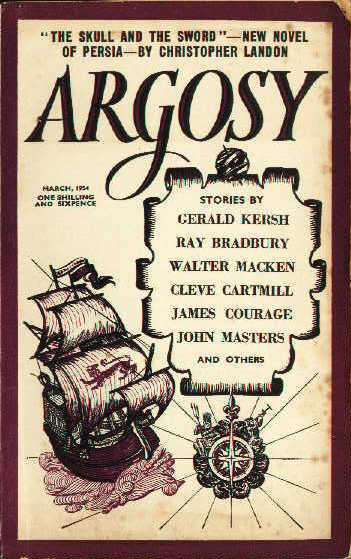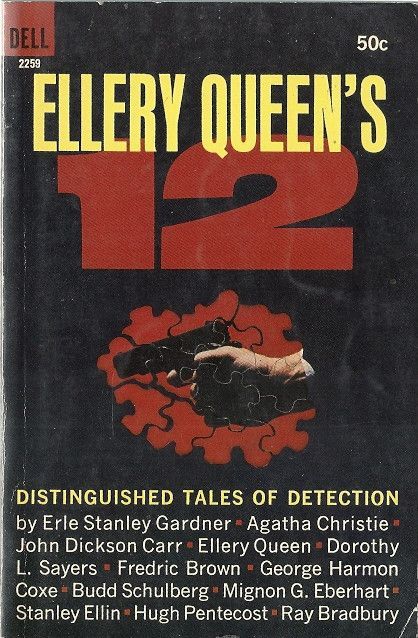"The Fruit at the Bottom of the Bowl."
By Ray Bradbury (1920-2012; ISFDb HERE).
Illustrated by Art Sussman (1927-2008; ISFDb HERE).
First appearance: Detective Book Magazine, Winter 1948,
as "Touch and Go!".
Many reprints:
Ellery Queen’s Mystery Magazine (EQMM), January 1953
Argosy (U.K.), March 1954
Cavalier, February 1960 (today's text)
Ellery Queen’s Anthology #3 (1962)
Ellery Queen’s 12 (1964)
Best Murder Stories (1965)
Mystery and Suspense Stories (1977)
Horror (1978)
Murder Most Foul (1984)
The Golden Apples of the Sun (1953)
Killer, Come Back to Me: The Crime Stories of Ray Bradbury (2020) (Reviewed HERE).
Short short story (7 pages).
Online at Archive.org starting (HERE; text pages 24-26), continuing (HERE; text page 57), still continuing (HERE; text page 66), even more (HERE; text page 68), and finishing (HERE; text page 70).
"The fingerprints were everywhere, everywhere!"
Shakespeare, as usual, got it right: "They whose guilt within their bosom lies, imagine every eye beholds their blame." In his mind, for this killer even the eyes of the smallest beholders, the ones that live in the walls, see his guilt . . .
Principal characters:
~ Donald Huxley:
"Pick it up. Turn it over. See the fine thinness of the bowl, hand-thrown on a turntable, thin as eggshell, incredible. And the amazing volcanic glaze? Handle it, go ahead. I don't mind."
~ William Acton:
"A long moment passed. Acton did not breathe. Without new air in his body he began to fail away, to sway; his head roared a silence of cold waves thundering onto heavy rocks."
~ Billy-boy:
". . . drunk as an owl, Huxley, old pal, drunker than two owls."
References and resources:
- "Out damned spot, eh, Acton?":
Quoting Lady Macbeth sleepwalking in her nightie. (Shakespeare Online HERE.)
- Murder comes in several varieties in the USA; which one do you think fits today's story? Think about it.
"First-degree murder:
"Any intentional killing that is willful and premeditated with malice aforethought. Felony murder, a charge that may be filed against a defendant who is involved in a dangerous crime where a death results from the crime, is typically first-degree, but may also be second-degree.
"Second-degree murder:
"Any intentional killing that is not premeditated or planned. A situation in which the killer intends only to inflict serious bodily harm, knowing this could result in death but with no specific intent to kill, constitutes depraved-heart murder, which can be considered as second-degree murder.
"Voluntary manslaughter:
"Sometimes called a crime of passion murder and informally called third–degree murder, this is any intentional killing that involves no prior intent to kill and which was committed under such circumstances that would 'cause a reasonable person to become emotionally or mentally disturbed'. Both this and second-degree murder are committed on the spot under a spur-of-the-moment choice, but the two differ in the magnitude of the circumstances surrounding the crime. For example, a bar fight that results in death would ordinarily constitute second-degree murder. If that same bar fight stemmed from a discovery of infidelity, however, it may be voluntary manslaughter.
"Involuntary manslaughter:
"A killing that stems from a lack of intention to cause death but involving an intentional act of negligence, which may or may not be premeditated, leading to death. A drunk driving-related death is typically involuntary manslaughter (see also vehicular homicide, causing death by dangerous driving, gross negligence manslaughter, and causing death by criminal negligence for international equivalents). Note that the 'unintentional' element here refers to the lack of intent to bring about the death. All three crimes above feature an intent to kill, whereas involuntary manslaughter is 'unintentional', because the killer did not intend for a death to result from their intentional actions. If there is a presence of intention it relates only to the intent to cause a violent act which brings about the death, but not an intention to bring about the death itself. However, there are exceptions, such as felony murder and depraved-heart murder, the latter of which can be considered as voluntary manslaughter or second-degree murder, instead of involuntary manslaughter, despite the lack of explicit intention to kill."
(Wikipedia HERE.)
TV Tropes also weighs in on the subject (WARNING! SPOILERS! HERE).
- "the old days when they rattled papyrus, flourished ink, dusted all with sand to dry the ink, and pressed their signet rings in hot crimson tallow at the bottom":
"Fingerprints have been found on ancient clay tablets, seals, and pottery. They have also been found on the walls of Egyptian tombs and on Minoan, Greek, and Chinese pottery. In ancient China officials authenticated government documents with their fingerprints. In about 200 BC, fingerprints were used to sign written contracts in Babylon. . . . References from the age of the Babylonian king Hammurabi (reigned 1792–1750 BCE) indicate that law officials would take the fingerprints of people who had been arrested. During China's Qin Dynasty, records have shown that officials took hand prints and foot prints as well as fingerprints as evidence from a crime scene." (From Wikipedia.)
Fingerprints are a major concern in our story; see Wikipedia (HERE) for a good summary.
- "my Gregorian [sic? possibly a misprint of Georgian] cutlery":
"The major items of cutlery in Western culture are the knife, fork and spoon. These three implements first appeared together on tables in Britain in the Georgian era." (Wikipedia HERE; also see HERE.)
- "ceramics by Gertrude and Otto Natzler":
"Gertrud Amon Natzler (1908–1971) was an Austrian-American ceramicist, who together with her husband Otto Natzler (1908-2007) created some of the most praised ceramics art of the 20th century, helping to elevate ceramics to the status of a fine art." (Wikipedia HERE and HERE.)
- For some reason "The Fruit at the Bottom of the Bowl" reminds us of Poe's "The Tell-Tale Heart" (online HERE).
 |
| Illustration by Virgil Finlay |
- We last perused Ray Bradbury's work with "Night Train to Babylon" (ONTOS HERE).
The bottom line:
Unless otherwise noted, all bibliographical data are derived from The FictionMags Index created by William G. Contento & edited by Phil Stephensen-Payne.
~~~~~~~~~~~~~~~~~~~~~~~~~~~~~~~~~~~~~~~~~~~~~~~~~~~~~~~~~~~~~~~~~~~~~~~~~~~~















No comments:
Post a Comment